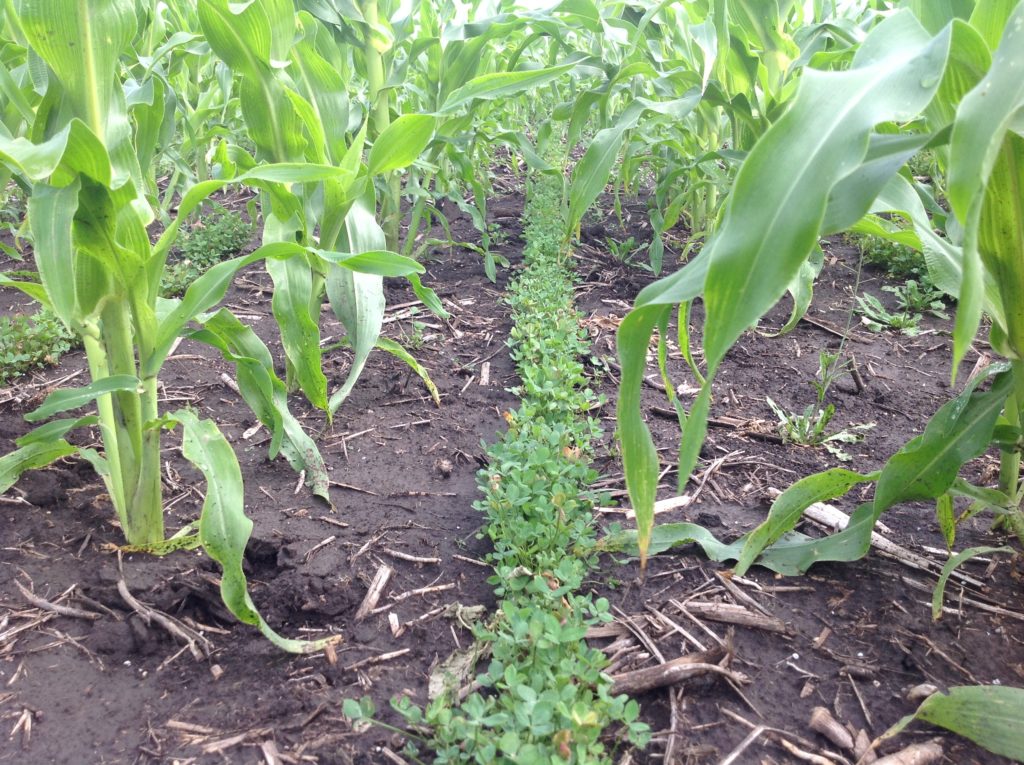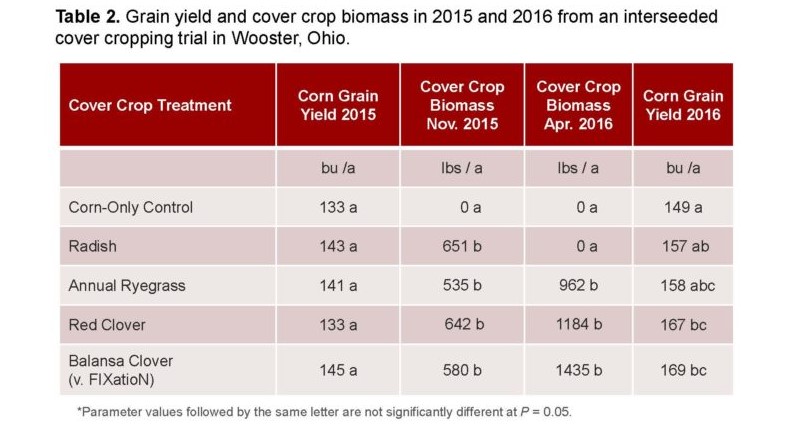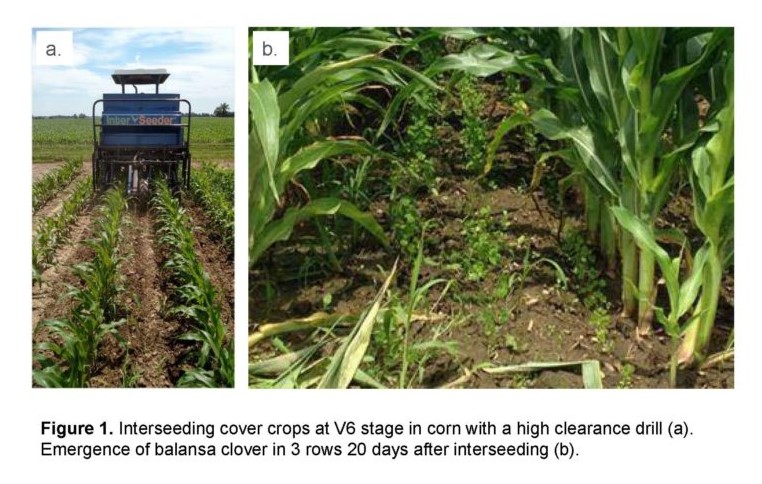If done correctly, inter-seeding cover crops into corn can uplift grain yields

To get a head start on establishing winter covers, interseeding has started to become a popular practice by producers in the northern region of the Corn Belt. Quite a bit of experimentation has been done over the last few years by farmers and researchers trying to dial in which species work best, when to plant, how to plant, and which herbicides to avoid.
Along with early establishment, the benefits of a diverse plant population can be cashed in by producers throughout the country. If done correctly, and with the right cover crop varieties, inter-seeding can significantly increase grain yields and reduce synthetic fertilizer requirements while improving soil health.
In a 2015-2016 trial conducted at The Ohio State University (OSU) by researcher Dr Ryan Haden, inter-seeding cover crops into corn improved grain yield by up to 12 bushels per acre compared to a corn monoculture.
Dr. Haden analyzed corn crop yield for two harvests of continuous corn after radish (var. Tillage Radish), red clover (var. Cinnamon Plus), Balansa clover (var. FIXatioN), and annual ryegrass (var. Tillage RootMax) were planted at the V5 stage using a high clearance drill. Cover crops were planted in three rows between 30-inch corn rows.
How To Interseed Cover Crops Into Corn?
Seeding should be done with a drill between the corn rows for best establishment. Broadcasting can work, but you’re depending on rain to get the seed worked into the soil. Depending on the species, seed rates may need to be set back by as much as 50 percent.

The earlier a cover crop can be drilled, the better chance it has for a successful establishment before the corn canopy begins to limit sunlight and moisture access. While the OSU trial inter-seeded into corn at the V6 stage, many have success when planting at the V3-V5 stage or even at the same time the corn is seeded.
On the GO Seed Research Farm, we used a high clearance drill to inter-seed cover crops into corn at the V6 growth stage in three rows spaced 7.5 inches between 30-inch corn rows. We did this for several reasons:
- Improved seed-soil contact
- Less dependent on weather
- More consistent establishment
- Can be seeded up to V6 in corn (maybe up to V7)
- A large menu of cover crop species can be used

The corn was a glyphosate-resistant variety planted at a population of 32,000 plants per acre on March 21. Glyphosate was sprayed to control weeds one day prior to inter-seeding cover crops into corn.
Grain yields at harvest were measured based on a 15.5% moisture content for corn grain. Cover crop biomass (reported on a dry weight basis) was measured in late November prior to the first killing frost, and in mid-April just prior to termination with herbicide.
Three Methods Of Interseeding
Typically, inter-seeding is classified as using a high-clearance drill like the one Dr. Haden used in his study. According to him, any method of establishment be it aerial seeding, broadcasting, or drilling, classifies as interseeding.
“Each of the methods has its pros and cons and will be a more suitable option for a business based on what equipment they already have, field conditions, and what their local aerial seeding market is like,” he says.
Aerial Seeding

When flying on cover crops, Dr. Haden advises seeding rates to be increased by 25-30 percent.
“Depending on how expensive your seed is, this can still be an affordable option because it gets the job done so quickly. Teaming up with your neighbors to fly cover crops on when crops are flown on can often help reduce costs further,” says Dr. Haden.
While aerial seeding can be a time saver and can allow producers the ability to take better advantage of timely rainfall, seed-to-soil contact is reduced compared to other methods which can make establishment less consistent.
Broadcasting

Similarly, to aerial inter-seeding, the broadcasting seed will need to have rates increased by 25-30 percent to make up in the reduced seed-to-soil contact.
For systems that cultivate deep furrows between corn, which is a common practice for organic growers, broadcasting is the best option available since drills will struggle with unevenness.
“Broadcasting seed may not seem like an attractive option to some because you’re having to increase seeding rates, have the right equipment, and spend time traveling across a field,” says Dr. Haden. “But the big thing to remember here is that a broadcast seeder can be relatively affordable to buy or rent for those wanting to not rely on contracting a pilot.”
Check out affordable options for planting green equipment.
High Clearance Interseeder Drill

A high clearance interseeding drill is going to offer the best seed-to-soil contact which will help manage seed costs when special varieties are being used.
“Some interseeder drills are capable of applying glyphosate and side-dress fertilizer in the same pass as planting, which is an attractive option for those planning to make interseeding an integral part of their long-term management system,” says Dr. Haden.
Challenges And Risks To Interseeding
When working with upper Midwest producers to take advantage of cover crops through inter-seeding, a common concern Dr. Haden came across was the fear that the cash crop yield would be hurt due to competition for water or nutrients.
“Creating biodiversity within fields by pairing the right cover crops and management strategy can bring multiple benefits to row crop systems, including improved soil health, weed suppression, and moisture management — without jeopardizing subsequent crop yield,” says Brent Jones, Iowa Research Farm Manager for GO SEED.
While it is common practice for cover crops to be established post-cash crop harvest, this can become a challenge for several reasons, says Dr. Ryan Haden, Associate Professor of Soil Science and Agronomy at Ohio State University.
“Regions with a shorter growing season can pose a challenge for establishing many cover crops after fall harvest due to the colder climate which limits early growth potential before plants go dormant. But even in good conditions, a lot of areas are limited on what species can be successful when seeded after corn or soybean harvest,” says Dr. Haden. “We also see challenges pop up in different areas of the country if harvest was delayed or fall weather patterns are wetter than normal.”
Drought
As with anything, there are risks and it seems that drought is one of the biggest when it comes to successfully establishing an inter-seeded crop into corn.
When we first heard of inter-seeding we thought we would try it on our SE Iowa research farm. The first year it worked well. I was nervous our annual clovers or annual ryegrass would quickly go to seed. However, it appears the shade from corn is enough to defeat the photoperiod maturity aspect of these species. The only spots where we saw any flowering were along the edge of the field, something that is easily adjusted for.
Our second year we planted later than I would have liked and it got too dry before we could get much size on the cover crops. As a result, most did not make it and we didn’t have much of a stand when the corn crop started to dry down. The one variety that did perform the best was our Frosty Berseem clover, which has better drought tolerance than the other species.
Later we tried to duplicate our trial on a nearby farm but pre-emergent herbicide residual kept anything from establishing. If you are going to try inter-seeding you will want to limit your use of pre-emergent herbicide or test germinate some quick germinating seed in an area where you can watch and water it regularly. If it doesn’t live where you baby it, don’t bother seeding across the rest of the field
Weeds & Herbicides
Fields without a lot of weed issues are best for inter-seeding cover crops into corn to avoid problems caused by herbicide residuals. After a spring burndown with glyphosate and 2,4-D, residuals will have to be avoided in order to get the cover crop established. If weeds will be a problem without a residual, then the chance of success is low.
While herbicides used for the inter-seeding growing year need to be compatible with the chosen cover crops, producers also need to look at their previous herbicide programs to ensure there are no issues from products with long residual effects. This can prevent seeds from germinating.
“Aside from carefully managing what products are being used, inter-seeding works well with side-dress N application for corn. I’ve found you can plant your cover crop, apply nitrogen, and spray post-emergent herbicide all in one go – saving a lot of time,” says Dr. Haden.
Get The Timing Right
Since corn is such a competitive plant, getting the inter-seeding time right is more about ensuring the incoming cover crop still has access to light before the canopy closes than the growth potential of the already established corn.
In his work, Dr. Haden has found inter-seeding to work best in corn when done during the V3 to V6 growth stages in conjunction with side dressing, allowing the cover crop to get established and grow before light access is closed off with the canopy. If a farm has missed that window, inter-seeding can be done later in the season once the corn plants have started to dry down and light is reaching the soil surface.
“The earlier you can get your cover crop in, the more you are going to be able to reap the benefits from it but getting it in later is better than not at all,” says Dr. Haden.
Best Cover Crops For Interseeding Into Corn
According to Jones and Dr. Haden, cover crops should be selected based on a field’s unique environmental challenges, specific goals a farm is trying to achieve, and the subsequent cash crop.

“Think of cover crops as a well-stocked toolbox,” says Jones. “Each species and variety can serve a particular purpose working towards a particular goal when managed correctly.”
Depending on your soil type, climate, and goals, there are multiple species of cover crops that can be successfully established into standing corn.
Legumes like red clover, cowpeas, crimson clover, berseem clover, and Balansa clover can fix atmospheric nitrogen to help feed the corn plants. Flowering plants like buckwheat and phacelia bring in beneficial insects to help keep harmful ones in check. Grasses with deep fibrous roots add carbon to the soil and help with water infiltration and retention.
However, because plants will go dormant in July and August when the corn canopy is closed, species must grow quickly, possess shade tolerance, and have an extensive root system to sustain themselves until the canopy opens at harvest. It is essential to choose cover crops based on variety traits, rather than buying variety-not-stated (VNS) seed. Traits like maturity and cold tolerance are important and will allow you to reach your goals.
While Dr. Haden has found both cover crop mixes and monocultures to be successful, he advises producers to only use radish as a monoculture since it is so dominant.
“Radishes are shade tolerant and do a fantastic job at protecting soil and breaking up compaction, but they tend to be dominant. This makes them great at smothering weeds for a clean field come spring, but they will also smother out other cover crops if their seeding rate in a mixture is too high,” he says.
Benefit Of Interseeding Cover Crops Into Corn
Perhaps the biggest benefit cover crops can bring to a cornfield is soil rejuvenation. Extensive root systems required to survive summer dormancy will loosen compaction while burrowing deep into the soil. A diverse mix of plants will also work together to form an underground network of fungal pathways and microorganisms that transfer and share vital plant nutrients like nitrogen, phosphorous, manganese, and sulfur.
While there are multiple species and multiple ways to inter-seed cover crops into corn, they all require careful and early planning for successful establishment. What works on one farm may not always work on yours so small-scale experimental trials are the best way to get started. If you have questions about how to incorporate interseeding into your crop system, feel free to give Grassland Oregon a call at 503-566 9900.
A practice increasing in popularity to overcome these challenges is to inter-seed cover crops into the cash crop early in the growing season before the canopy closes.
“Generally, the inter-seeded plants get started, put down good roots, then go dormant while the cash crop canopy shades them. Once the crop is harvested, they are ready to grow again,” says Jones.
Not only is getting a cover crop established before the cash crop is taken off giving more northern regions the ability to take advantage of increased biodiversity, but it’s also opening up options for species that more moderate climates can use.
“After corn, most regions are typically limited to cereal rye or wheat to get the crop established before cold weather sets in. Interseeding allows time to establish crops like clovers and radish that have huge soil and nutrient benefits but need more time to get going,” says Jones. “For farmers planning to graze cornstalks for winter feed, inter-seeding is also a great way to provide cows with additional forage without having to haul in hay.”
OSU Study: Interseeding Cover Crops Into Corn at V6
We felt that we had learned enough that when we were approached by Dr. Ryan Haden of Ohio State to help fund his inter-seeded cover crop trial, we were happy to do so.
See Dr. Ryan Haden’s presentation below.
In the OSU inter-seeding trial, FIXatioN Balansa Clover contributed to the greatest grain yield increase by an additional 12 bushels per acre and was second in biomass measurements. Because it has been bred specifically to fix significant amounts of nitrogen from the environment into soil, the companion and subsequent crops can cash in on 100’s of pounds of free nitrogen.
The variety has also been bred for cold tolerance, surviving in sub-freezing temperatures at minus 20 degrees Fahrenheit with zero snow cover. However, if VNS Balansa clover seed was used instead, yield, nitrogen fixation, biomass and persistence could be inconsistent from field to field, and may not respond well to the environment.
Interseeding Is Not For Beginners
Both Jones and Dr. Haden stress that inter=seeding is not a management practice that should be attempted by novice cover croppers and should only be done by those with experience.
A good intermediate step, says Dr. Haden, is to experiment with frost-seeding red clover into winter wheat to get experience in managing two different crops at the same time.
If it is a practice that a farm is interested in trying, Jones says to learn as much as possible from other producers practicing it before doing test plots.
“Interseeding is not for the faint of heart. Getting your timing right and the selection of the right species and varieties can make or break it for you,” he says. “Learn as much as you can from others and take it slow. The benefits can be monumental to an operation, but things must be managed right first.”
Editor’s note:
Cover Crop Corner is a new educational column from forage application company Grassland Oregon and free for print or digital distribution by media outlets. To be added to the distribution list, please email info@goseed.com
Click HERE for a printable PDF version of this article.


